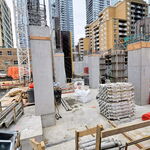Awareness is one issue, but I think actual mechanisms that prevent potential track intrusion is more foolproof and has operational benefits (especially since the system is moving towards higher frequency trains - you really don't want these types of incidents to cripple the system the way they do on TTC).
Or both -- the hazard stripes, the light strip, and the physical barrier. Not mutually exclusive. Begin immediately with the easy/simple stuff like the light strip. The flashing light strip would warn when the barrier is coming up/down, too. That said, there is a headache for when the platform is so crowded a wheelchair person can't back away from a raising barrier, so there's some difficult decisions to be made (e.g. sensors). With so many 300 meter platforms, and the possible mechanical issues, especially in the winter with muddy/salty shoes, it may be infeasible maintenance-wise at Union station's scale (more than 1/2 kilometer of raisable platform walls per track!) with major service disruption when platform lowering fails.
However, 300 meters of a common infrastructure-rated waterproof LED strip reel (amber color, a few dollars to a few tens dollars per meter, something far more durable than the cheap reel stuff) rolled out and mounted inside an industrial plexiglas-windowed rectangular metal tube (3cm wide x 2cm deep) mounted to the small vertical platform walls on both sides of the track, would cost a mere few thousand per platform to install and easily maintained at night. This could be combined in with the USRC upgrades and new train traffic control centre -- a good initial stopgap with and/or without physical barriers. At about 1 watts per meter for fairly bright (but not obnoxiously bright) amber LEDs, it would consume only 300 watts for the whole platform length (600 watts for two edges of platforms); and only consume power briefly while a train was approaching/departing. It could even steadily illuminate as platform-gap safety lighting while the train is stopped with doors open.
And being LED, would be extremely durable for years, with main risk being temperature swings and vibration damage causing breaks in the ribbon, but such ribbon is frequently used in adverse conditions and even underwater nowadays, and would be easily replaceable at night in ~5 meter segments, it wouldn't be embedded into the platform but as a ~2cm protrusion off the vertical surface of the low platform wall (roughly stairstep height) near the platform edge. So easy nighttime maintenance and no service risk upon failure (flashing failure), and upgradeable (e.g. replacement with more power-efficient, more durable industrial LED ribbon strips as they get released in the future, in standardized 12-volt 5-meter ribbon lengths; Some are cheap like $10 from china for 5m, at $2/meter, while other waterproof building exterior industrial ribbons costing $100+ per 5 meter roll, but probably cheaper in large quantities -- but all of them are 12 volt standardized reel ribbons. Pretty safe voltage.)

(This LED ribbon is waterproof and encased in plastic. But a more industrial version thereof -- there are building-exterior-rated ones frequently used to illuminate Las Vegas casinos too; easily installed & mounted below the platform on the platformwall above track; inside ~2cm x ~3cm metal rectangular ducting with plexiglass window strip -- for further weatherproofing -- and along entire platformwall of both sides of all platforms, slow-flashing 1 Hz during approaching/departing trains, steady illumination as platform edge safety light while train is stopped at platform. Carefully choose a strong industrial version rated for building exteriors & survives winter-time temperature swings, spending $100 per 5 meter rather than cheap ebay $10 per 5 meter).
!WARNING!: A train is approaching behind you; please step away from platform edge NOW!
!WARNING!: A train is approaching behind you; please step away from platform edge NOW!
Credit: Photoshopped version of
Michael Kappel on flickr
Amber/yellow is an international hazard color; often flashing at stop sign intersections, school crossings, pedestrian crossings, etc. Slow flashing frequency, approximately 1 Hertz. Some city commuter/metro systems use a variant of this.
OFF: No train is currently approaching
FLASHING: (1 Hertz) Train is approaching or departing (step away from platform edge NOW. FINES ENFORCED.)
STEADY ON: Train is currently stopped at platform. Safety platform gap lighting.
(could also fade on-off for gentler flash, or dimmer if this is too bright)
Even if it just save just ONE life within the next 10 years, it'll have been worth it. And it's not mutually exclusive with other physical barrier upgrades too. We are becoming one of the busier low-platform stations in the modern Western world, and we are unfortunate to be saddled with narrow platforms and GO trains with dangerous undercarriages and protrusions; therefore this is a critical cheap safety modification of Union Station. Even just in the interim. Do it, please.
Cost estimate: A
mere $100,000 for the entire Union station for top-quality waterproof ribbon and mounts, plus install labour cost. An economic fraction of a human life! This can actually save money; by potentially reducing Union station insurance costs too!
[EDIT to add enforcement reinforcement:]
Enforcement is easy:
- Today, lots of people step forward on yellow line at familiar predicted door locations while train is still moving!
- Fare inspectors wait at Union station anyway to board their trains. Utilize this resource!
- Fare inspector pre-located standing on crowded platform a couple feet to side of where train doors will stop. Within arm's reach, standing spread-leg just behind yellow line to the side, in a way to occupy enough space to safely pull aside one person.
- All the fare inspector needs to do is reach out an arm. The embarassment of being pulled a couple feet aside & fined in front of crowd near predicted door location. Use a moderate/low fine initially (e.g. $20) that's sufficient enough to deter, "people have been killed by moving trains, this is why these fines exists", so people never become angry enough to "never take GO trains again".
- The embarassment in front of crowd actually outweighs the fine, and actually deters rest of the crowd. So only moderate enforcement is required to make this extremely effective (never step on yellow line; fare inspector may be watching).
- Occasional enforcement blitzes easily catching people who step forward on predicted door locations while the train is still only halfway in the station, will dramatically improve compliance elsewhere in Union station, and could actually save 1 life per 10 years. Easy fish. Like shooting fish in a barrel!
- Heck, be nice, do phased-in introduction. Start with warning citations, followed by low fines, followed by very high fine (fines potentially raised after next injury of flashing-light-ignoring person).
- Coverage on social media by guilty commuters "oops, I stepped on yellow line during flashing [photo of my fine ticket]", news, twitter, coworkers, parents/family, reinforces public to stay away from platform edge.
- And the death rate at Union is higher than that currently, even saving 1 life for only $100,000 of cheap retrofits, is well worth it.
- Enforcement should also occur on unruly behavior. GOtrain traffic control centre should keep all Union station video footage long enough to cover all "contested fine" events.
- "Flashing light" = "You'red fined if you're on the yellow line while light is flashing"
- Union station commuters become more well-behaved as a result, too.
We are gradually going to become one of the busiest low-platform train stations in the western world, so we need inexpensive mitigation measures such as these. $100,000+labour for flashing platform lights, and moderate enforcement.
No need for enforcement whenever platform lights are not flashing; strong fine enforcement during flashing lights = public stays away from platform edge during approaching/departing trains. Rude passing people now know to stop walking on yellow line immediately the platform edge light begins to flash. Eventually, after sufficient enforcement, most people stop feeling it's worth walking down the platform while it's crowded, and/or stay still and/or stay in the concourse.







